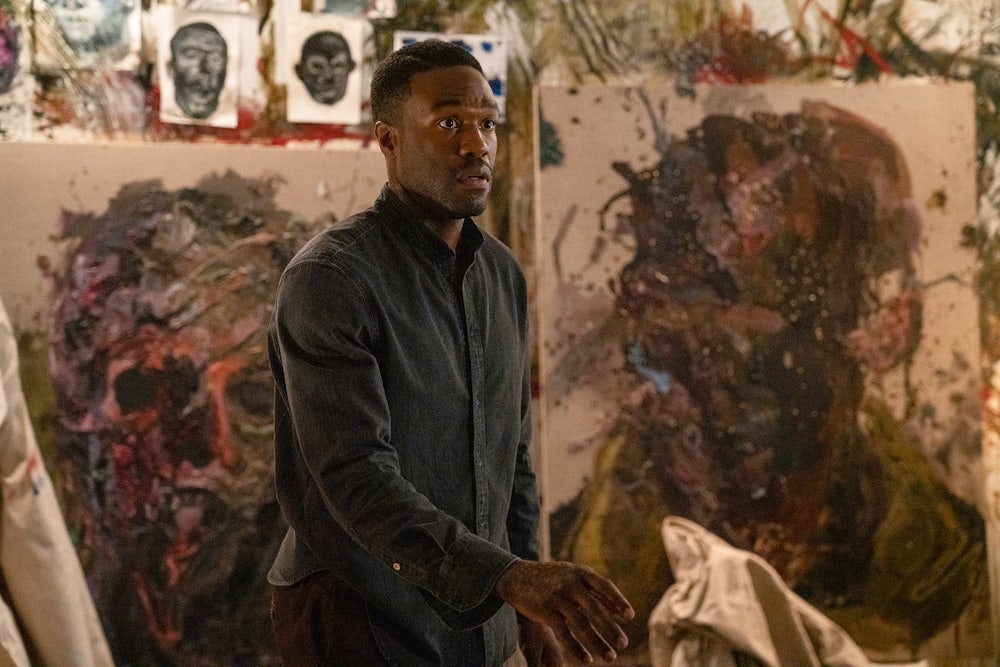“Your disbelief destroyed the faith of my congregation. Without them, I am nothing, so I was obliged to come. And now I must kill you.” Thus spake Tony Todd in the 1992 movie Candyman, clad in a gorgeous calf-length shearling coat and beckoning to Helen Lyle (Virginia Madsen) seductively with his hook for a hand. Though his lines are few, Todd brought a luminous intensity to his role as the shade of Daniel Robitaille, an “urban myth” that Helen provokes into existence when she starts researching supernatural occurrences at the Cabrini-Green Homes, the vast housing project in Chicago.
A white graduate researcher at the University of Illinois Chicago,* Helen spends the first half of the film knocking on Cabrini-Green residents’ doors and taking photographs of graffiti. But later, Helen learns that Robitaille, a nineteenth-century Black artist, romanced a white woman and was lynched by a white mob who severed his hand, covered him in honey and angry bees, then set him on fire. As a result, he haunts the spot, his pain living on like a stain on the earth. If you say his name five times in a mirror, he appears to slit your belly open with the hook jammed in his arm. Helen’s professor boyfriend, who is also white, calls stories like Candyman “modern oral folklore; the unselfconscious reflection of the fears of urban society.” Helen is clearly trained in the same condescending anthropological mode, treating the residents more like datasets than people, a fact that outrages Candyman. He feels that her very methods sow “disbelief” in his legend, and are therefore acts of violence against him. The roles of villain and hero start to melt into one another.
As well as a somewhat abstruse plot, Candyman has much dialogue that is poetic and vague, and the ending is unhappy, which may be why the film was never a big commercial hit. But it built up cult status for Todd’s blistering embodiment of the role—he was stung by bees 23 times during the filming, for which he negotiated a $23,000 bonus—and its social commentary. The film came out a few months after the Los Angeles riots, and its violence still reads as a kind of controlled artistic response to real-world events—to the brutality of the videotaped police beating of Rodney King, as well as to Hollywood’s tropes for depicting Black pain. Candyman gave you the ghost’s hook creeping under the hem of a dress; the blood pooling on the floor of an apartment kitchen. Both deliberate and surreal, the action of Candyman feels dreamlike, even dictated by the logic of the subconscious. Madsen was said to have met with a hypnotist before going on set for her scenes with Todd, to intensify the surrender he commands from her.
Last year, the director Jordan Peele spoke of Candyman as “one of the few movies that explored any aspect of the Black experience in the horror genre in the ’90s, when [he] was growing up.” That has now changed, partly as a result of Peele’s own work. Get Out, his 2017 horror movie in which white supremacist families steal Black people’s bodies, enraptured audiences and critics with its almost offhand mastery of everyday, subtle racism, and notably featured violence more coercive than bloody.
This Friday, a sharp new version of Candyman hits theaters, produced by Peele’s Monkeypaw Productions and directed by Nia DaCosta (Little Woods). In contrast to the ambiguity of the original film, DaCosta has created a Candyman that takes for granted much that seemed fresh in 1992. Instead, her film asks what problems or dangers attend a commercial movie about Black pain.
Anthony McCoy (Yahya Abdul-Mateen II), the protagonist of 2021’s present-day Candyman, resembles Helen Lyle insofar as they are both seekers. He’s a painter who lives in a fashionable loft in the post-gentrification Cabrini-Green area with Brianna, his art curator girlfriend (played heroically by Teyonah Parris) who nurses his wobbly, fledgling career. Anthony’s gallerist is disappointed by the painter’s latest work. “I want the great Black hope of the Chicago arts scene ... of tomorrow!” he says. The works that made Anthony famous are of ropes around necks, and they’re no longer new.
Unhappy that Brianna has moved to Cabrini-Green, her brother (the always-enjoyable Nathan Stewart-Jarrett), a realtor who says the area is haunted despite its glamorous new sheen, tells a scary story one night about a woman named Helen who went on a killing spree there. It’s a warped version of the events of the 1992 Candyman, and DaCosta depicts this new story, as well as others in the movie, through a shadow puppet sequence designed by Chicago-based studio Manual Cinema. In it, bodies become weightless, sliced through by paperweight hooks and tossed by the whims of the storyteller—it’s effective, less atmospheric than efficient, even matter-of-fact. The film’s whole aesthetic, in fact, is clean and precise, returning our attention to the unsaid and the unseen rather than seducing us with the painterly drama of the original.
The shadow puppets let DaCosta inject a lot of extra plot into the movie, including scenes of lynching that would be too graphic to show directly. With these techniques of hiding and revealing, DaCosta develops a political argument about what it means to make art under capitalism: Retelling a story about human agony for money can be so painful that it’s as if the events are happening all over again, only worse. Anthony decides to pursue Cabrini-Green as a subject for his new painting series, in a project called Say My Name. When his art is mentioned on television news in relation to an exceptionally gory murder, Anthony says in wonder under his breath, to Brianna’s horror, “They said my name!” Later, “Say my name” will appear on a wall written in blood, and it’s unclear who put it there.
The motif riffs on the way people summon Candyman in a mirror—literally by saying his name—and underscores the way naming can be a powerful but unpredictable way to process trauma and grief. The phrase echoes #SayHerName, the campaign to remember Black women killed by police in the United States. Anthony’s need for recognition and achievement make him hunger for the sound of his own name, and nobody else’s. There are many more valences to the phrase—the Destiny’s Child song appeared in an early trailer for the film, in the Peele signature move of juxtaposing upbeat pop hits with horror—and it’s the clash of those meanings, rather than any simple symbolism, that makes its use devastating in the film.
It would spoil the plot to give away the precise form of Anthony’s unraveling, or how exactly Candyman relates to the subject of his paintings, but it involves a riveting appearance by Vanessa Estelle Williams, who also appeared in the 1992 film as a young mother frantic with worry that Candyman will kill her son. Too late, Anthony realizes that invoking powerful, painful old stories for the gratification of an audience who won’t necessarily understand them can sow consequences beyond his control.
In an essay occasioned by Amazon’s horror series Them, Hannah Giorgis wrote for The Atlantic in April that “productions that engage with that real-life terror can, at times, feel more like brutal reenactments of senselessness than purposeful works of art, unintentionally compounding some Black viewers’ traumas.” Some critics of the 2021 Candyman have argued that the film falls prey to exactly such problems, which also plagued the poorly received movie Antebellum and the bloody miniseries Lovecraft Country last year. In a compelling review at Vulture, Angelica Jade Bastién finds DaCosta replaying old scenes of violence against Black people without offering any kind of meaningful catharsis or commentary on the subject.
But it may matter for the new Candyman that its protagonist is not a white anthropologist, but a Black artist, which makes it possible to read Anthony’s disintegration as a question as well as a spectacle. In this view, he asks: Is it worse to go unrepresented in culture, as Peele observed in his own childhood, or be wrung out for profit by gatekeepers who see the market value in your pain? If the 1992 film leaned into old tropes around race in white movies in order to highlight their persistence, this new Candyman arguably addresses itself to a new problem, in which Black pain is very much for sale in Hollywood horror. Articulating trauma can commodify it, the art scene of Candyman demonstrates, by both alienating the artists themselves and making the audience complicit in perpetuating the same images of violence.
There are a few gaps in the film’s depiction of Anthony’s artistic process; we don’t get to see much brush-on-canvas action, for example. Instead, DaCosta uses precise camerawork and clever, subtle mirror shots to suggest what the 1992 version does with atmosphere: that it’s seductive but dangerous to name the worst of anybody’s traumas anywhere, but especially in the vicinity of a mirror.
* An earlier version of this article stated that Helen Lyle was a student at the University of Chicago. She was a student at the University of Illinois Chicago.








